It's no secret that today the building materials market presents a huge variety of various materials of the highest quality. Many of them on construction jargon are designated by abbreviations, for example, GLK, GVL, which is not always clear by the average man. So let's figure it out that let's indicate letters, including the CML.
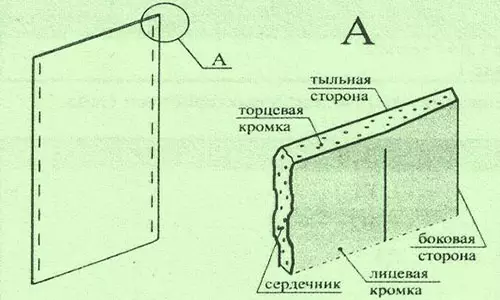
The structure of GCL.
What does the abbreviation of GLK?
It is all the famous plasterboard. It is a composite building material, which is based on the notorious plaster.Gypsum is located inside, and on top it is lined with an ordinary cardboard. With the abbreviation we figured out, another question pops up: what is GLK in construction?
Plasterboard is an indispensable material when mounting suspended ceilings, hiding various defects of wall surfaces, when creating a house and in the partition office.
Plasterboard - the unique material that is sometimes indispensable when implementing some designer ideas in the decoration finishing. The possibilities of using drywall are almost not limited. With the help of moisture-resistant drywall, partitions are created or a cortic in the bathroom. His consumption is insignificant if professionals will be taken for work.
With plasterboard, in general, everything is clear. But why do you usually use GLK and GVL? What is their connection?
Everything is much easier than many might think. Gvl is called drying. It is an eco-friendly material, indispensable in construction. Hypus fiber is very durable, solid material with fire and technical characteristics. Therefore, dry-fiber is used in the base of the base of the floor, as well as for cladding the structures of the tree in order to increase their fire resistance.
But the gypsum is not as popular as plasterboard, so we will dwell in more detail.
Application of drywall
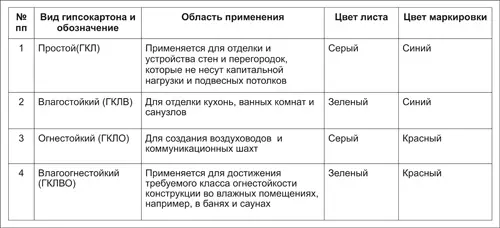
Types of plasterboard, scope and their color marking
With the help of drywall, you can both align and simply update the old walls and partitions. Due to this material, the repair of surfaces is carried out without dust and dirt. This is the first, which is distinguished by plasterboard sheets from other building materials.
Also with it, you can give the walls of any form that you like. Another advantage of drywall is its low weight and economical consumption, due to which it becomes simply an indispensable material in places where it is impossible to apply a classic finish due to a number of reasons.
Also from drywall can easily make interroom partitions on a metal or wooden frame.
Gypsum panels are an indispensable tool when finishing and aligning the surface of the ceiling.
With it, you can perform any kind of ceiling: suspended, multilevel, ordinary, etc.
Article on the topic: What powder is better to choose for a washing machine-machine?
The area of application of plasterboard is not limited to smooth surfaces, because Glk is very easy to bend. In order to do this, it is necessary to simply moisten with water, and after giving it the necessary form, simply dry the flow of warm air.
Thanks to this ability, GLCs are simply indispensable when creating complex decorative elements, which distinguishes it from a variety of building materials.
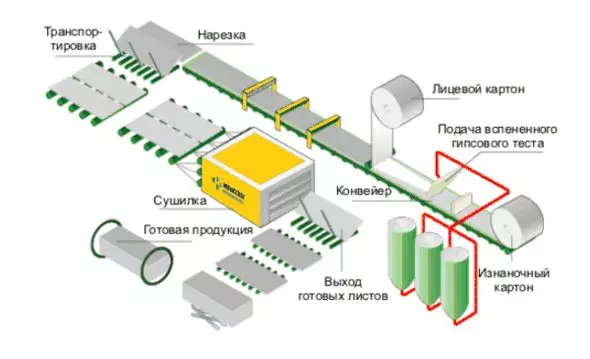
Diagram of production of plasterocraton
Plasterboard sheets exist several varieties:
- Ordinary (GLC);
- Moisture-resistant (G CLEB).
Their most important difference is moisture absorption. G Clac absorbs 2 times less fluid than GKL. Accordingly, partitions and walls have a longer service life.
It is very easy to distinguish them - in color. Moisture-resistant gypsum sheets are burst with a green shade cardboard, and ordinary - gray.
Work with any type of gypsum material is better to start when the humidity in the room is not more than 60%. Standard drywall is designed for the premises of dry, with a normal level of humidity.
Some recommendations
If you decide to put partitions from this material in the kitchen or in the bathroom, it is better to give preference to moisture-resistant option. But it is necessary to establish an exhaust ventilation and protect the surface of the HCLV waterproof emulsion, a waterproofing composition, a coating of polychlorine or ceramic tiles.
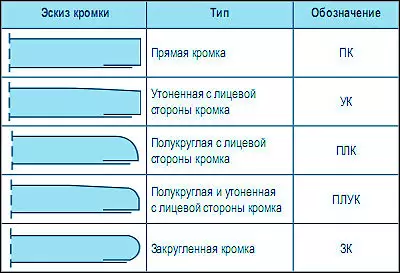
Types of edges of drywall.
In addition to the 2nd types of drywall, there are some more:
- GKLO, which is characterized by increased resistance to open fire;
- Glevo, which is a moisture-resistant material with an increased resistance to an open flame.
So, plasterboard is 4 species. The big plus of this material is its small consumption, since the sheets are quite large. But this wonderful construction element has a disadvantage: it grows quite a large space when the partition is erected at the expense of the frame. But it's all the little things compared to the spectrum of its use.
All waterproofing works are made before applying facing material. If the plans to attach some heavy equipment on the walls or partitions from drywall, for example, the sink, then it is necessary to build mortgage parts into it at the frame assembly stage, for example, metal strips. G Clac better to mount a couple of layers with each of the sides.
This material has many differences in the type of edges:
- PC is a straight, intended for dry installation, without sealing formed joints, be it partitions or a ceiling.
- The Criminal Code is intended for installation, which provides for the seal of the joints with a putty with a reinforcing grid.
- PLC - semicircular shapes from the front side, is designed for installation that provides for the sealing of the joints with putty without using the reinforcing grid.
- Pluk - semicircular shapes, bevelled from the front side, is designed for installation, which provides for the sealing of the junctions as with the reinforcing grid, and without it.
- ZK - rounded, designed for installation, which provides for subsequent shocking.
Article on the topic: How to cut the curtains with lambrequins: Calculation of patterns and cutting parts
Knowing these abbreviations, you can easily calculate the approximate consumption of building material before starting repair.
What does the abbreviation of the CML mean?
So, the CML is a glass adhesive sheet. It is a finishing material in the form of a sheet, is positioned as a substitute for GLC and GWL and other sheet materials for finishing the premises.
So better: sml or gvl? In fact, everyone is responsible for this question in his own way. Someone more souls are plasterboard, and someone is a glass adhesive sheet.
Let us dwell on it in more detail.
The glass adhesive sheet is a versatile construction and finishing material with a unique set of different characteristics. There is simply no analogues to this material today. There is also an economical consumption, which is important today.
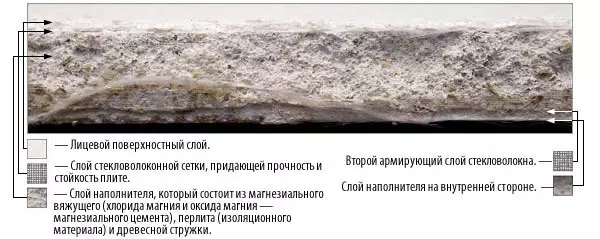
The CML has a unique combination of operational and structural properties.
The main components is:
- Magnesium oxide. Initially, Magnezit is taken - natural material extracted by an open method from quarries, then it is purified from different impurities and grind into powder.
- Magnesium chloride. Bishifitis is a natural material that includes a chloride magnesium-sodium complex.
- Wood chips.
- Perlite - is the breed of volcanic origin extracted by the shaft method. It is used as heat - and soundproofer.
- Fiberglass. It is used as a reinforcing material in the production of the CML. It has excellent thermal insulation qualities, has an increased resistance to acid and alkaline effects, to the effect of various organic solvents. The material consumption depends on the characteristics of the insulation of the premises.
As can be seen from the above, the vomagnesite sheet is a natural building material that does not harm health.
It is worth noting that the glass magnesite sheet, unlike many other building materials intended for interior decoration, is very convenient when installing, it has incomparable flexibility and durability, and, in addition, it is also moisture consists, and non-flamm.
Due to this, the scope of the application of the CML is satisfied is extensive. It (SML) can be used both for internal and for external cladding of buildings for building structures. It is also suitable for mounting the ceilings, when creating a interroom partition, etc. The consumption of the material, as well as in the case of plasterboard, it will not be very large.
Article on the topic: Mixing assembly for a warm floor: installation with your own hands
In addition, the magnetist is used for production:
- Construction forms.
- Shields for advertising.
- Door cloths.
- Facing and reinforcement of foam concrete blocks.
- Non-removable formwork in the walls of buildings under foam concrete.
If we consider it entirely natural and environmentally friendly composition, then it is possible to start talking about its widest use without feasibility for life, despite what was the consumption of material and the difference in relation to other species.
This material has an aseptic property, i.e. does not create optimal conditions for the reproduction of microorganisms and therefore remains hygienic, the entire operational period remains hygienic.
Material features
The processing of the CML is also performed simply as in the case of GLC (drywall). Namely, special tools and special skills are required. I want to repeat that the consumption of this material is relatively small than it differs significantly from other finishes.
In addition, it is possible to take a small weight of such plates to the pros, which will noticeably simplifies the installation of the material. The quality of the glass adhesive sheet is determined by the amount in its magnesia, which should be considered when purchasing. Of course, the higher the quality, the higher and, respectively, the price. But it is better to pay a little more than a quality come true.
As it is clear, the magnetist has no analogues in the building materials market. It has the unique combination of operational and structural properties.
Today we reviewed 3 types of building materials that are most popular at the moment.
This is a plasterboard, denoted by the abbreviation of GKL, a dry-fiber, known to many as GVL, innovative material of the glass turbine leaf, or a cm.
Each of the above building materials has its own unique properties, characteristics and scope of application. It cannot be said that any of these materials is excellent, and some kind of bad, because They are just all different.
In general, they only have fire resistance and a relatively small consumption during finishing.
Therefore, before running to acquire some of the above materials, you should first think what properties should it have that you are waiting for the material where it will be applied (inside the building or outside). For external cladding, it is still better to prefer the CML than ordinary drywall. Good luck!
